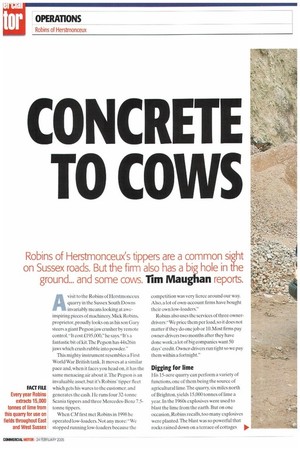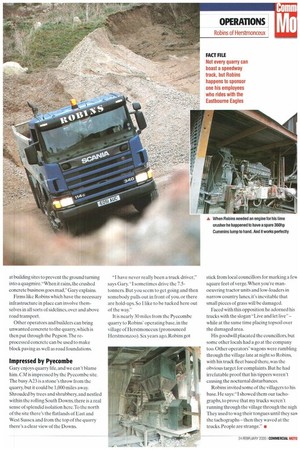CONCRETE TO COWS
Page 54

Page 56

Page 57

Page 59

If you've noticed an error in this article please click here to report it so we can fix it.
Robins of Herstmonceux's tippers are a common sight
on Sussex roads. But the firm also has a big hole in the
ground... and some cows. arim Mau an reports.
Avisit to the Robins of Herstmonceux quarry in the Sussex South Downs invariably means looking at aweinspiring pieces of machinery. Mick Robins, proprietor, proudly looks on as his son Gary steers a giant Pegson jaw crusher by remote control."It cost £195,000," he says."It's a fantastic bit of kit.The Pegson has 44x26in jaws which crush rubble into powder."
This mighty instrument resembles a First World War British tank. It moves at a similar pace and, when it faces you head on, it has the same menacing air about it.The Pegson is an invaluable asset, but it's Robins' tipper fleet which gets his wares to the customer, and generates the cash. He runs four 32-tonne Scani a tippers and three Mercedes-Benz 7.5tonne tippers.
When CM first met Robins in 1998 he operated low-loaders. Not any more:"We stopped running low-loaders because the competition was very fierce around our way. Also, a lot of own-account firms have bought their own low-loaders."
Robins also uses the services of three ownerdrivers: "We price them per load, soil does not matter if they do one job or 10. Most firms pay owner-drivers two months after they have done work; a lot of big companies want 50 days' credit. Owner-drivers run tight so we pay them within a fortnight."
Digging for lime
His 15-acre quarry can perform a variety of functions, one of them being the source of agricultural lime.The quarry, six miles north of Brighton, yields 15,000 tonnes of lime a year. In the 1960s explosives were used to blast the lime from the earth. But on one occasion, Robins recalls, too many explosives were planted.The blast was so powerful that rocks rained down on a terrace of cottages 101. several hundred feet from the cliff face.
Robins bought the site in 1971 and today, the extraction methods are less spectacularbut the firm still rewards the cottagers with an annual Christmas hamper.
The firm has two excavators, a 35-tonne Samsung and a 30tonne Komatsu. Bought second-hand at three or four years old, they cost about £40,000 apiece. "The excavators pull the lime out, and then the tippers collect it," he says. "After that the lime goes into a hammer mill, which smashes the lime into powder. It's used by farmers, to sweeten acidic soil."
Making it tick
Crushed concrete is dropped at the site by Robins' vehicles, as well as other operators' trucks. It makes this quarry tick," says Robins and this staple work justifies the pricey Pegson, which grinds the concrete down into powder.
Protected by safety rails, we peer down into the mighty Pegson as it does its stuff on a batch of concrete. Robins and other operators take the powder to road building sites where it's used in the construction of road bases.
Hours can be long in this tipper market Mick's wife, Irene, generally makes a 6.30am start with an 8.30pm finish. "I'm a jack of all trades," she says. "I turn the computers on at six thirty and then! send the drivers off. spend the rest of the day answering the phones, and dealing with the drivers if they have a problem."
In family firms like these, names have a habit of appearing out of the blue. Gary's wife Helen deals with staff wages; Mick's son John drives the lighter tippers. Irene describes her work as "hectic-. Marshalling HGVs can indeed be busy work, but Irene, as well as handling this task, also handles a job few tipper operators' wives have to worry about. The Robins have 64 hectares of agricultural land which are home to a 60-strong herd of cows.The calving season runs from midMarch to mid-May, and Irene has the critical task of pulling the calves from their mothers. "I'm the midwife," she smiles.
She also arranges the movement of the company's excavators. Here, Robins operators are supplied along with the equipment.The firm is able to haul its smaller pieces of plant to site, but when the larger gear needs moving the family calls in the services of low-loader specialists. Robins does advertise its services, although such marketing exercises tend to be low-key.The company has carved out its niche in East and West Sussex, and so most work is generated by word of mouth.
That said, the firm does participate in a spot of sponsorship. Edward Kennett, one of Robins' employees, is a top speedway rider.The firm delivers materials to Eastbourne Eagles Speedway; in return the venue displays an advertising board publicising Robins of Herstmonceux's services. Gary Robins has even created a speedway track within the quarry for 18-year-old Kennett to practice on.
Out of the ground
Robins stands out from the crowd because rather than simply transporting lime it draws the substance from the very earth. The tipper fleet is dispatched around East and West Sussex. It's based in Herstmonceux but makes the daily trip to the quarry. Gary arrives at the quarry on a Monday morning at 8am sharp. His first task is to arrange shovel loading, which drops lime intc the tippers. Before it's ready for delivery the lime has to be crushed.
This stage of the cycle makes for interestinl vievving.Ten years ago, Mike decided to harness a tractor unit engine to the crusher. The concept was a success and these days, the lime crusher —housed in a large shed — is powered by a 360hp Cummins engine.
"We're busy with the lime in spring and autumn," says Gary.
In wet weather, crushed concrete is droppec at building sites to prevent the ground turning into a quagmire."When it rains, the crushed concrete business goes mad," Gary explains.
Firms like Robins which have the necessary infrastructure in place can involve themselves in all sorts of sidelines, over and above road transport.
Other operators and builders can bring unwanted concrete to the quarry, which is then put through the Pegson.The reprocessed concrete can be used to make block paving as well as road foundations.
Impressed by Pyecombe Gary enjoys quarry life, and we can't blame him. CM is impressed by the Pyecombe site. The busy A23 is a stone's throw from the quarry, but it could be 1,000 miles away. Shrouded by trees and shrubbery, and nestled within the rolling South Downs, there is a real sense of splendid isolation herc.To the north of the site there's the flatlands of East and West Sussex and from the top of the quarry there's a clear view of the Downs. "I have never really been a truck driver," says Gary. "I sometimes drive the 7.5tonners. But you seem to get going and then somebody pulls out in front of you, or there are hold-ups. So I like to be tucked here out of the way?'
It is nearly 30 miles from the Pyecombe quarry to Robins' operating base, in the village of Herstmonceux (pronounced Herstmonzoo). Six years ago. Robins got stick from local councillors for marking a few square feet of verge. When you're manoeuvring tractor units and low-loaders in narrow country lanes, it's inevitable that small pieces of grass will be damaged.
Faced with this opposition he adorned his trucks with the slogan "Live and let live" — while at the same time placing topsoil over the damaged area.
His goodwill placated the councillors, but some other locals had a go at the company too. Other operators' wagons were rumbling through the village late at night so Robins, with his truck fleet based there, was the obvious target for complaints. But he had irrefutable proof that his tippers weren't causing the nocturnal disturbances.
Robins invited some of the villagers to his base. He says:"1 showed them our tachographs, to prove that my trucks weren't running through the village through the nigh. They used to wag their tongues until they says the tachographs — then they waved at the trucks. People are strange." •










































































































































































































